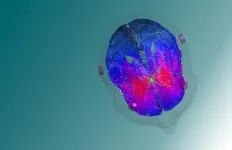(Press-News.org) What makes chocolate taste and smell so delicious? Chemistry, of course! A variety of molecules work together to create that unmistakable aroma, but those same molecules might carry some unwanted health effects if there are too many around. According to research published in ACS’ Journal of Agricultural and Food Chemistry, while many of the compounds appeared in chocolate in low enough concentrations to be safe, higher amounts were found in some baked sweet treats.
When making chocolate, cocoa beans are roasted to help their chocolatey flavors shine. During this process, new molecules like α,β-unsaturated carbonyls are formed when they react with other ingredients under high temperatures. This class of carbonyls is highly reactive and potentially genotoxic, or able to cause damage to DNA when consumed. Though naturally found in many foods, these carbonyls are also used as flavoring additives, and some have been banned in the European Union, including the buttery-tasting furan-2(5H)-one. To better understand how these molecules form naturally in foods, and whether or not they are present in levels that could pose a health concern, Alexandre Dusart and colleagues tested chocolates and other sweet treats for 10 different α,β-unsaturated carbonyls — some of which have been confirmed as safe by the European Food Safety Authority, while others are still under evaluation.
The team created its own chocolates and found that α,β-unsaturated carbonyls formed during roasting and after the addition of cocoa butter; however, their concentrations remained too low to pose any health concerns from consuming the chocolates. Next, researchers screened 22 commercially available desserts, including crepes, waffles, cakes and biscuits, either with or without chocolate. In these packaged treats, they found even lower concentrations of nine of the 10 carbonyls compared to the chocolates.
The remaining carbonyl — genotoxic furan-2(5H)-one — appeared in much higher concentrations in the crepe and cake samples, reaching up to 4.3 milligrams per kilogram. Considering that the recommended threshold for genotoxic substances is only 0.15 micrograms per person per day, consuming these desserts could exceed that limit, though additional studies are needed to accurately assess the potential health risk.
Researchers concluded that the furan-2(5H)-one molecule likely formed during the baking process and did not seem to correlate with the amount of chocolate present in the packaged desserts. The team says that this work helps to better understand where these carbonyls come from in chocolate and highlights the importance of monitoring flavorings in food to keep consumers informed and safe.
The authors acknowledge funding from the Belgian Federal Public Service of Health, Food Chain Safety and Environment.
The paper’s abstract will be available on May 29 at 8 a.m. Eastern Time here: http://pubs.acs.org/doi/abs/10.1021/acs.jafc.4c01043
###
The American Chemical Society (ACS) is a nonprofit organization chartered by the U.S. Congress. ACS’ mission is to advance the broader chemistry enterprise and its practitioners for the benefit of Earth and all its people. The Society is a global leader in promoting excellence in science education and providing access to chemistry-related information and research through its multiple research solutions, peer-reviewed journals, scientific conferences, eBooks and weekly news periodical Chemical & Engineering News. ACS journals are among the most cited, most trusted and most read within the scientific literature; however, ACS itself does not conduct chemical research. As a leader in scientific information solutions, its CAS division partners with global innovators to accelerate breakthroughs by curating, connecting and analyzing the world’s scientific knowledge. ACS’ main offices are in Washington, D.C., and Columbus, Ohio.
To automatically receive news releases from the American Chemical Society, contact newsroom@acs.org.
Note: ACS does not conduct research, but publishes and publicizes peer-reviewed scientific studies.
Follow us: X, formerly Twitter | Facebook | LinkedIn | Instagram
END
New York, NY, May 29, 2024 — The New York Academy of Sciences and the Leon Levy Foundation announced today the 2024 cohort of Leon Levy Scholars in Neuroscience, continuing a program initiated by the Foundation in 2009 that has supported 170 fellows in neuroscience.
This highly regarded postdoctoral program supports exceptional young researchers across the five boroughs of New York City as they pursue innovative neuroscience research and advance their careers toward becoming independent principal investigators. Nine scholars were competitively selected for a three-year term from a broad pool of applications from more than a dozen ...
The number of refugees has sharply increased in recent decades, reaching 37.8 million in 2022. Amidst this surge, host communities—locals residing in areas where refugee camps are situated—are also positively and negatively impacted by the refugee influxes. The negative impacts include competition over scarce resources and in the unskilled labor market. While the international media and aid organizations put the spotlight on assisting refugees, the challenges faced by host communities are frequently sidelined.
In 2017, over ...
If we want cleaner air, fewer forest fires, and less severe climate change, a new UC Riverside study shows we must reduce aerosol pollution and greenhouse gases like carbon dioxide at the same time.
The study found that boreal forests in the northern hemisphere are particularly vulnerable to negative effects of cleaning up aerosol pollution. This includes forests in Canada, Alaska, northern Europe, and northern Russia.
Aerosols are small particles like dust and sea salt as well as airborne chemicals produced by fossil fuel combustion. They are responsible for poor air quality. The UCR study, published in the journal ...
A small interfering RNA (siRNA) investigational therapy that inhibits a gene involved in lipoprotein metabolism has been shown in a clinical trial led by Mount Sinai researchers to significantly reduce levels of different types of cholesterol and triglycerides in individuals with mixed hyperlipidemia, a condition in which fats build up in the blood.
In addition to seeing promising preliminary results related to safety and efficacy in clinical trials, the Mount Sinai researchers found the RNA interference (RNAi)-based therapy zodasiran to be a potentially promising option for substantially reducing a number of atherogenic lipoproteins while requiring less frequent ...
Spend any time scrolling through social media or news sites and it feels like America is a nation in constant argument. Off-hand remarks often spark fierce screaming matches. Partisanship is up, Gallup tells us, while trust in institutions is down.
However, a new study co-authored by Berkeley Haas Assistant Professor Erica R. Bailey suggests this perception may not accurately reflect the nature and frequency of political debates among everyday Americans. In three studies involving nearly 3,000 participants, researchers found most debates ...
By Dylan Walsh
Some of human history’s greatest atrocities—genocide, slavery, ethnic cleanings—are rooted in our ability to dehumanize people from other social, political, or cultural groups.
Whereas prior research has traced dehumanization to the belief that others think or feel less than we do, new research co-authored by Haas professor Sameer Srivastava shows that our tendency to dehumanize can also be influenced by how we think others view important facets of the world. The greater ...
Research Highlights:
The benefits gained from better heart health may be related to a process involved in the aging of the body and its cells, researchers found in a study of more than 5,000 adults with a mean age of 56 years.
People with rapid cell aging may offset the increased risk of heart disease, stroke and death by managing their heart disease risk factors and adopting more heart-healthy behaviors, researchers said.
Embargoed until 4 a.m. CT/5 a.m. ET Wednesday, May 29, 2024
DALLAS, May 29, 2024 — The benefit of better heart health may be associated with the positive impact of heart healthy lifestyle factors on biological aging (the age of the body and its ...
Neurological disorders, such as addiction, depression, and obsessive-compulsive disorder (OCD), affect millions of people worldwide and are often characterized by complex pathologies involving multiple brain regions and circuits. These conditions are notoriously difficult to treat due to the intricate and poorly understood nature of brain functions and the challenge of delivering therapies to deep brain structures without invasive procedures.
In the rapidly evolving field of neuroscience, non-invasive brain stimulation is a new hope for ...
An analysis by researchers in the Department of Psychiatry at the University of Arizona College of Medicine – Tucson showed that risks for death by suicide and homicide peak at night, with nocturnal wakefulness, age, alcohol use and relationship conflicts being especially prevalent as contributing factors.
Nearly 19% of suicides and 36% of homicides occur at night. Suicide and homicide share little in common, but their highly concordant overnight risk patterns suggest a common feature: nocturnal ...
City officials were more likely to maintain climate action during the pandemic in places with more climate-related health issues affecting residents.
Cities around the world were more likely to maintain climate action and enact ‘green recovery’ long-term plans after the pandemic if local decision-makers were more alert to the health risks of climate change, a new global study has shown.
The health benefits of tackling climate change, such as cleaner air and more access to green spaces, were key ...



